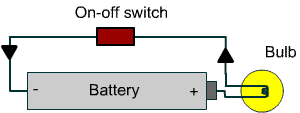|
Direct current or DC electricity is the
continuous movement of electrons from an area of
negative (-) charges to an area of positive (+) charges
through a conducting material such as a metal wire.
Whereas static electricity sparks consist of the sudden
movement of electrons from a negative to positive
surface, DC electricity is the continuous movement of
the electrons through a wire.
A DC circuit is necessary to allow the
current or steam of electrons to flow. Such a circuit
consists of a source of electrical energy (such as a
battery) and a conducting wire running from the positive
end of the source to the negative terminal. Electrical
devices may be included in the circuit. DC electricity
in a circuit consists of voltage, current and
resistance. The flow of DC electricity is similar to the
flow of water through a hose.
Questions you may have include:
Continuous movement of electrons
DC electricity is the continuous
movement of electrons through a conducting material such
as a metal wire. The electrons move toward a positive
(+) potential in the wire.
In reality, there are millions of
electrons weaving their way among the atoms in the wire.
This is just an illustration of the movement.
An electrical circuit consisting of a
source of DC power and a wire making a complete circuit
is required for DC electricity to flow.

A flashlight is a good example of a DC
circuit
Although the negative charged electrons
move through the wire toward the positive (+) terminal
of the source of electricity, the current is indicated
as going from positive to negative. This is an
unfortunate and confusing convention.
Ben Franklin originally named charges
positive (+) and negative (-) when he was studying
static electricity. Later, when scientists were
experimenting with electrical currents, they said that
electricity travels from (+) to (-), and that became the
convention.
This was before electrons were
discovered. In reality, the negative charged electrons
move toward the positive, which is the opposite
direction that people show current moving. It is
confusing, but once a convention is made, it is
difficult to correct it.
Voltage, current and resistance
The electricity moving through a wire or
other conductor consists of its voltage (V), current (I)
and resistance (R). Voltage is potential energy, current
is the amount of electrons flowing through the wire, and
resistance is the friction force on the electron flow.
A good way to picture DC electricity and
to understand the relationship between voltage, current
and resistance is to think of the flow of water through
a hose, as explained below.
A potential or pressure builds up at one
end of the wire, due to an excess of negatively charged
electrons. It is like water pressure building up in a
hose. The pressure causes the electrons to move through
the wire to the area of positive charge. This potential
energy is called Voltage, its unit of measurement is the
Volt.
The number of electrons is called
current and its unit of measurement is the Ampere or
Amp. Electrical current is like the rate that water
flows through a hose.
An Ohm is the unit of measurement of the
electrical resistance. A conductor like a piece of metal
has its atoms so arranged that electrons can readily
pass around the atoms with little friction or
resistance. In a nonconductor or poor conductor, the
atoms are so arranged as to greatly resist or impede the
travel of the electrons. This resistance is similar to
the friction of the hose against the water moving
through it.
The following chart compares water
running in a hose and DC electricity flowing in a wire:
| pressure |
potential (V) |
Volts |
| rate of flow |
current (I) |
Amps |
| friction |
resistance (R) |
Ohms |
Analogy between a Hose and Electricity
in a Wire
Creating DC electricity
Although static electricity can be
discharged through a metal wire, it is not a continuous
source of DC electricity. Instead, batteries and DC
generators are used to create DC.
Batteries rely on chemical reactions to
create DC electricity.
The automobile battery consists of lead
plates in a sulfuric acid solution. When the plates are
given a change from the car's generator or alternator,
they change chemically and hold the charge. That source
of DC electricity can then be used to power the car's
lights and such. The biggest problem with this type of
battery is that sulfuric acid is very caustic and
dangerous.
Another battery that you can make
yourself is a lemon battery. This one needs no charging
but depends on the acidic reaction of different metals.
Copper and zinc work the best. You can
use a copper penny or copper piece of wire. A
zinc-coated or galvanized nail can be used as the other
terminal. A standard iron nail will work, but not as
good.
Push the copper wire and galvanized nail
into an ordinary lemon and measure the voltage across
the metals with a voltmeter. Some people have been able
to dimly light a flashlight bulb with this battery.
Another reliable source of DC
electricity is the DC generator, which consists of coils
of wire spinning between North and South magnets. (See
Generating Electrical Current for more information.)
Direct current or DC electricity is the
continuous movement of electrons from negative to
positive through a conducting material such as a metal
wire. A DC circuit is necessary to allow the current or
steam of electrons to flow. In a circuit, the direction
of the current is opposite the flow of electrons. DC
electricity in a circuit consists of voltage, current
and resistance. The flow of DC electricity is similar to
the flow of water through a hose. Batteries and DC
generators are the sources to create DC electricity. |